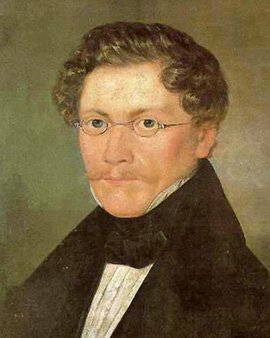Carl Spitzweg's works show contemporary life in the late 19th and early 20th centuries with a sharp but loving eye. Gentle irony and satire as well as detailed depictions of life circumstances and landscapes are formative elements. The childhood and youth of Carl Spitzweg were decisive for this development. Carl Spitzweg was born in Munich in an upper middle-class environment. Both parents were wealthy. His mother Franziska was the daughter of a rich fruit wholesaler. His father ran a successful trade in spices, today this would be understood as a spice trade. The family's financial circumstances enabled Carl Spitzweg to be largely independent. The painter grew up with an older and a younger brother. When he was eleven years old, his mother died. The father's plans envisaged that the eldest son would take over the business. The youngest son was to become a doctor, and for Carl he wanted a career as a pharmacist.
Although his artistic talent was evident early on - the first drawing dates from 1823 - Carl Spitzweg initially followed his father's wishes. He completed an apprenticeship with Franz Xaver Pettenkofer at the Royal Bavarian Court Pharmacy in Munich. When he was in his last year of apprenticeship, his father died. Carl Spitzweg completed his apprenticeship and moved to the Löwenapotheke in Straubing. Here he spent a lot of time with painters and theatre people in addition to his professional activities. He then began to study pharmacy, chemistry and botany at the University of Munich. After graduating with distinction, he was admitted as a practical pharmacist and worked in several pharmacies. But the urge to paint was unbroken. After a long illness and a stay at a health resort, Carl Spitzweg decided to paint full-time. The inheritance from his parents' fortune gave him a good start in his artistic life.
Carl Spitzweg never enjoyed an artistic education. As a typical autodidact, he worked out his skills all by himself. He became a member of the Munich Kunstverein and made friends with fellow painters. His circle of friends included Dietrich Langko, Friedrich Voltz, Eduard Schleich and Christian Morgenstern. Travel in general and study trips were very important for Spitzweg. He visited Dalmatia and Venice, Paris, London and Antwerp. He also visited cities within Germany, for example Frankfurt and Heidelberg. His pictures were often humorous depictions of the petty bourgeoisie, often caricatures with a humorous background were created. As an employee of the "Fliegende Blätter", a humorous weekly magazine, he made numerous drawings. Spitzweg also concentrated more and more on landscape painting. Success was not long in coming. Spitzweg's paintings sold well even during his lifetime. A special distinction was the award of the Bavarian Order of Michael. In addition, Carl Spitzweg was an honorary member of the Academy of Fine Arts in Munich in the last years of his life. Spitzweg was intensely occupied with the composition of colours. His experience as a pharmacist and his knowledge of chemistry were of great benefit to him. He produced his own colours, and a special, brightly shining blue became very famous.
×





.jpg)
.jpg)
.jpg)
.jpg)
.jpg)
.jpg)
.jpg)
.jpg)
.jpg)
.jpg)
.jpg)
.jpg)
.jpg)
.jpg)
.jpg)
.jpg)
.jpg)
.jpg)
.jpg)
.jpg)
.jpg)
.jpg)
.jpg)
.jpg)
.jpg)
.jpg)
.jpg)
.jpg)
.jpg)
.jpg)
.jpg)
.jpg)
.jpg)
.jpg)
.jpg)
.jpg)
.jpg)
.jpg)
.jpg)
.jpg)
.jpg)
.jpg)
.jpg)
.jpg)
.jpg)
.jpg)
.jpg)
.jpg)
.jpg)
.jpg)
.jpg)
.jpg)
 - (MeisterDrucke-148102).jpg)
 - (MeisterDrucke-148102).jpg)
.jpg)
.jpg)
.jpg)
.jpg)
.jpg)
.jpg)
.jpg)
.jpg)
_Um_1837_-_(MeisterDrucke-805088).jpg)
_Um_1837_-_(MeisterDrucke-805088).jpg)
_-_(MeisterDrucke-686955).jpg)
_-_(MeisterDrucke-686955).jpg)
.jpg)
.jpg)
.jpg)
.jpg)
.jpg)
.jpg)
.jpg)
.jpg)
.jpg)
.jpg)
.jpg)
.jpg)
.jpg)
.jpg)
.jpg)
.jpg)
.jpg)
.jpg)
.jpg)
.jpg)
.jpg)
.jpg)
.jpg)
.jpg)
.jpg)
.jpg)
.jpg)
.jpg)
.jpg)
.jpg)
.jpg)
.jpg)
.jpg)
.jpg)
.jpg)
.jpg)
.jpg)
.jpg)
.jpg)
.jpg)
.jpg)
.jpg)
.jpg)
.jpg)
.jpg)
.jpg)
.jpg)
.jpg)
.jpg)
.jpg)
.jpg)
.jpg)
.jpg)
.jpg)
.jpg)
.jpg)
.jpg)
.jpg)
.jpg)
.jpg)
.jpg)
.jpg)
.jpg)
.jpg)
.jpg)
.jpg)
.jpg)
.jpg)
.jpg)
.jpg)
.jpg)
.jpg)
.jpg)
.jpg)
.jpg)
.jpg)
.jpg)
.jpg)
.jpg)
.jpg)
.jpg)
.jpg)
.jpg)
.jpg)
_1839_-_(MeisterDrucke-983934).jpg)
_1839_-_(MeisterDrucke-983934).jpg)
.jpg)
.jpg)
.jpg)
.jpg)
.jpg)
.jpg)
.jpg)
.jpg)
.jpg)
.jpg)
.jpg)
.jpg)
.jpg)
.jpg)
.jpg)
.jpg)
.jpg)
.jpg)
.jpg)
.jpg)
.jpg)
.jpg)
.jpg)
.jpg)
.jpg)
.jpg)
.jpg)
.jpg)
.jpg)
.jpg)
_-_(MeisterDrucke-1089756).jpg)
_-_(MeisterDrucke-1089756).jpg)
.jpg)
.jpg)
.jpg)
.jpg)
.jpg)
.jpg)
.jpg)
.jpg)
.jpg)
.jpg)
.jpg)
.jpg)
.jpg)
.jpg)
.jpg)
.jpg)






